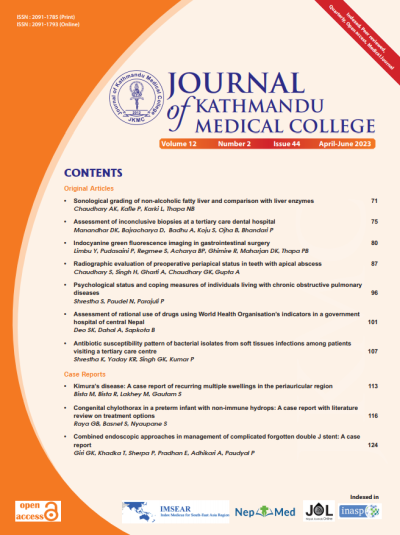Assessment of inconclusive biopsies at a tertiary care dental hospital
DOI:
https://doi.org/10.3126/jkmc.v12i2.53544Keywords:
Histopathological report, Inconclusive biopsy, Oral pathologistAbstract
Background: Biopsy has crucial role in definitive diagnosis of lesions followed by appropriate treatment of the same. There are situations to clinicians when the report from the oral pathologists comes as “inconclusive biopsy”, instead of a definitive diagnosis.
Objectives: To determine the frequency and reasons for inconclusive biopsy as the final diagnosis, in biopsy samples obtained for histopathological evaluation.
Methods: This retrospective chart review was conducted in a total of 982 biopsy reports from the archive of the Department of Oral Pathology of Kantipur Dental College. Reports from 2016 to 2021 A.D were assessed after institutional ethical approval utilising convenience sampling. Clinical details were assessed from the patient's biopsy requisition form. Inconclusive diagnosis as the final sign-outs were evaluated, to analyse the reasons for such reports according to the standard criteria. For analysis, SPSS v.20 software was used.
Results: Out of 982 biopsy reports, 140 (14.2%) inconclusive biopsy reports were recovered. The reasons for inconclusive biopsy in descending order was 129 (92.1%) poor quality of sample, five (3.6%) insufficient biopsy, three (2.1%) inappropriate fixative, two (1.4%) both insufficient and poor-quality sample and one (0.7%) lack of clinical or radiographic details. Comparison between central and peripheral inconclusive reports was not statistically significant (p >0.05).
Conclusion: This study indicates that careful surgical approach is a must along with proper transportation of the biopsy sample and a detailed clinical and radiographic information to avoid inconclusive biopsy reports.
Downloads
Downloads
Published
How to Cite
Issue
Section
License
Copyright (c) 2023 Journal of Kathmandu Medical College

This work is licensed under a Creative Commons Attribution-NonCommercial 4.0 International License.
Copyright © Journal of Kathmandu Medical College
The ideas and opinions expressed by authors or articles summarized, quoted, or published in full text in this journal represent only the opinions of the authors and do not necessarily reflect the official policy of Journal of Kathmandu Medical College or the institute with which the author(s) is/are affiliated, unless so specified.
Authors convey all copyright ownership, including any and all rights incidental thereto, exclusively to JKMC, in the event that such work is published by JKMC. JKMC shall own the work, including 1) copyright; 2) the right to grant permission to republish the article in whole or in part, with or without fee; 3) the right to produce preprints or reprints and translate into languages other than English for sale or free distribution; and 4) the right to republish the work in a collection of articles in any other mechanical or electronic format.




